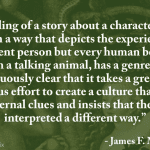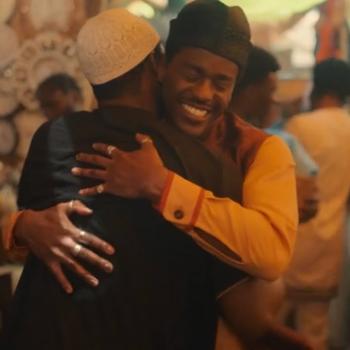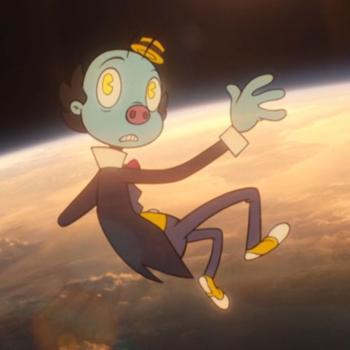I decided to wait until the second part aired before blogging about this episode, since the first part ended with a cliffhanger and a major reveal that had fans excited. As the title suggests, the episode is having fun parodying the spy thriller genre in general and the James Bond franchise in particular. In the story, aliens have been attacking and rewriting the DNA of spies around the world. As the Doctor and companions work with MI-6 to investigate, they are put in touch with an operative nicknamed “O” (poking fun at “M” and “Q”) who recommends looking for the spymaster. He later reveals that he meant the spy-Master, and that he is the Doctor’s oldest frenemy. Sure, we saw Missy dying, unable to regenerate. But apparent fatality has never stopped the Master from returning before, and so why should this time be any different?
Anyway, I’m glad I waited, because while the first part before the reveal at the end seemed like a lighthearted spoof (the Doctor mistakes which game they are playing in a casino, and there’s a car and motorbike chase for good measure), the second part picks up by diving deep into classic Doctor Who and its mythology. While some of the time travel solutions to problems reminded me a tad too much of “The Curse of Fatal Death,” on the whole it made for a nice balance between old and new, classic Who mythology and new directions, exciting action and humor. There was also a fun bit in connection with that which directly recalled “Blink,” but this time with the Doctor saying they shouldn’t shout at the screen since it is a recording. (That episode is a good intro to Doctor Who if you’ve never watched it, although if you’ve never watched it, I doubt you’re reading this, alas.)
There are a lot of wonderful aspects of the episode. One is that the Doctor finds that the alien spies are embedded to watch key figures in the development of human computer technology, which leads her to meet not only or even primarily Charles Babbage, but more importantly Ada Lovelace (then still Ada Gordon…awkward!), and later Noor Inayat Khan. It turns out that the alien spies are aiming to turn human DNA into data storage. The tech CEO who has been working with them as well as the Master mocks an audience telling them they kept clicking “agree” and now we can do anything.
In terms of Doctor Who’s mythology and the grand narrative arc, those things were front and center. It is a problem that Gallifrey’s bubble universe is now reachable by the Doctor and the Master, without explanation of how that can be given the apparent impossibility (or at least improbability, given what we saw in “Listen”) of reaching it. But that is overshadowed by the Master’s claim that Gallifrey has been devastated, nuked, its inhabitants obliterated. The Doctor doesn’t believe him at first, but then goes to see and finds it is true – at which point the Master reveals that he himself inflicted that carnage on their home planet, because as he said at the end of part 1, “Everything you think you know is a lie.” Here he elaborates saying that the founding fathers of Gallifrey based their entire society on a lie, and had to be made to pay, mentioning in the process the mysterious “timeless child” mentioned tantalizingly in the episode “The Ghost Monument.” He says, “The whole existence of our species is built on the lie of The Timeless Child. Do you see it? It’s deep in all of our memories, our identity.” It would be amazing (if convoluted) if it turns out that this connects up with the old Cartmel Masterplan, with the Doctor (and perhaps now also the Master) turning out to be the earliest of the time lords, with suppressed memories about who or what they were before. It will be interesting to see where this goes, but after an often lighthearted, morality tale, new monsters rather than old first season with Jodie Whittaker as the Doctor, here the show seems to be headed in a very different direction, one that will explore mythology and the Doctor’s identity in ways that the show regularly has throughout its history, knowing that hints and slow reveals related to this are part of what makes the show great along with all the other things I mentioned.
In terms of a writing project I’m working on related to Doctor Who, there were some important moments that I’ll need to reflect on and incorporate. On the one hand, Khan says she is a pacifist, and the Doctor says she identifies as one as well, calling it a bold stance to take in a time of war. On the other hand, earlier the Doctor was assisted by a steam-gun firing, prototype grenade lobbing Ada Gordon, and while the Doctor said she doesn’t approve, she also said that she’s “got an Ada” in a manner equivalent to and an equal match for the Master’s weapon. I’ll be thinking about how this relates in particular to the Doctor’s flexible creed about guns and weapons in “The Battle of Ranskoor av Kolos,” and how all of that in turn relates to what Davros says about the Doctor turning companions into weapons in “Journey’s End.”
There are a number of great lines in the episode. “Where there’s risk, there’s hope.” “Darkness never sustains, even though sometimes it feels as though it might.” In the dialogue between the Doctor and Noor Khan, the latter asks if the fascists win, and the Doctor says, “never.” And before erasing a very reluctant Ada Gordon’s memories of her, the Doctor poignantly says, “Ada, you don’t need a preview, you’ll figure it out before anyone.”
See also Paul Driscoll’s post and James Whitbrook’s for reactions and questions after the first part aired, and take a look at this hilarious bit of trivia about Sacha Dhawan learning that he’d be playing the Master…while filming with Peter Capaldi! And of course, see my past blogging on earlier episodes that connect with this one…













